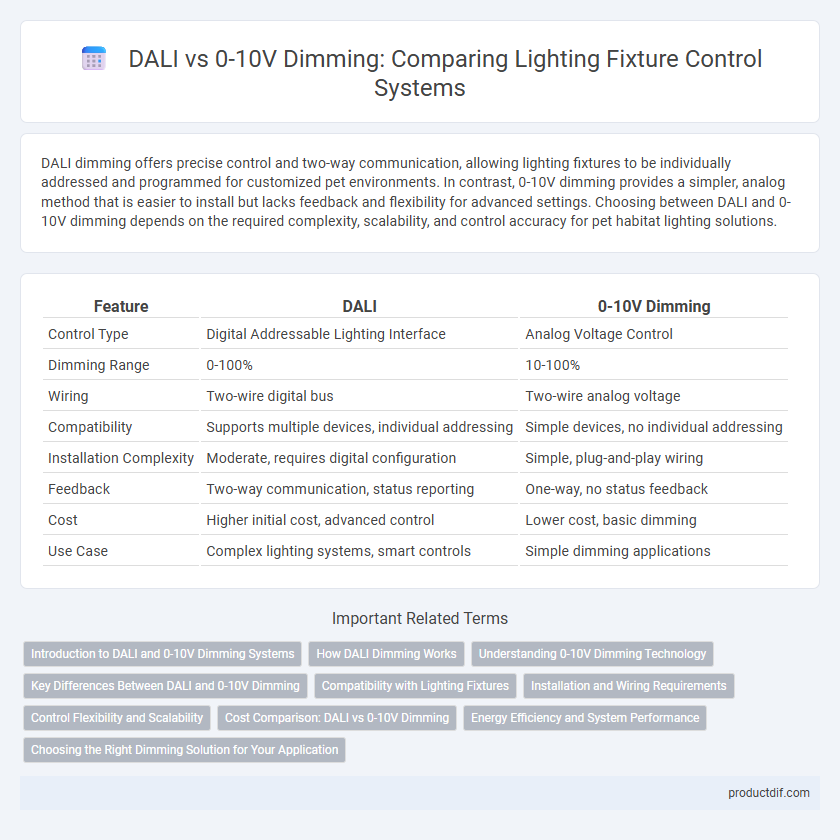DALI dimming offers precise control and two-way communication, allowing lighting fixtures to be individually addressed and programmed for customized pet environments. In contrast, 0-10V dimming provides a simpler, analog method that is easier to install but lacks feedback and flexibility for advanced settings. Choosing between DALI and 0-10V dimming depends on the required complexity, scalability, and control accuracy for pet habitat lighting solutions.
Table of Comparison
| Feature | DALI | 0-10V Dimming |
|---|---|---|
| Control Type | Digital Addressable Lighting Interface | Analog Voltage Control |
| Dimming Range | 0-100% | 10-100% |
| Wiring | Two-wire digital bus | Two-wire analog voltage |
| Compatibility | Supports multiple devices, individual addressing | Simple devices, no individual addressing |
| Installation Complexity | Moderate, requires digital configuration | Simple, plug-and-play wiring |
| Feedback | Two-way communication, status reporting | One-way, no status feedback |
| Cost | Higher initial cost, advanced control | Lower cost, basic dimming |
| Use Case | Complex lighting systems, smart controls | Simple dimming applications |
Introduction to DALI and 0-10V Dimming Systems
DALI (Digital Addressable Lighting Interface) and 0-10V dimming are two prevalent lighting control systems used to regulate fixture brightness. DALI operates via a digital protocol allowing individual addressability and bi-directional communication between controllers and luminaires, enhancing flexible lighting management. In contrast, 0-10V dimming uses a simple analog voltage signal ranging from 0 to 10 volts to control brightness levels, offering straightforward implementation but limited control granularity.
How DALI Dimming Works
DALI dimming operates through a digital communication protocol that sends precise signals to lighting fixtures, allowing individual or group control of brightness levels with high accuracy. Each DALI-compatible fixture has an address, enabling customizable settings and two-way feedback for status monitoring and fault detection. This digital system supports complex lighting scenes and smooth transitions, enhancing energy efficiency and user experience compared to analog 0-10V dimming.
Understanding 0-10V Dimming Technology
0-10V dimming technology operates through a direct current control voltage ranging from 0 to 10 volts, which adjusts the light output linearly based on the voltage level. This analog dimming method is widely compatible with various lighting fixtures and drivers, making it a straightforward solution for simple dimming needs. Unlike DALI systems, 0-10V lacks bidirectional communication, limiting its ability to provide feedback or support advanced lighting controls.
Key Differences Between DALI and 0-10V Dimming
DALI (Digital Addressable Lighting Interface) offers precise, bidirectional digital communication, enabling individual control and status feedback for each fixture, while 0-10V dimming relies on a simpler analog voltage signal for basic dimming functionality. DALI systems support advanced features such as scene setting, group control, and error reporting, whereas 0-10V is limited to straightforward intensity adjustment without communication capabilities. The scalability and flexibility of DALI make it suitable for complex smart lighting projects, whereas 0-10V is often preferred for cost-effective, less sophisticated dimming applications.
Compatibility with Lighting Fixtures
DALI dimming offers superior compatibility with modern lighting fixtures by supporting networked control and individual addressability, making it ideal for complex lighting systems. In contrast, 0-10V dimming relies on analog voltage signals, which can limit precise control and compatibility with newer fixtures that require digital communication. Choosing DALI ensures seamless integration with smart lighting setups, while 0-10V is typically favored for simpler, legacy installations.
Installation and Wiring Requirements
DALI dimming systems require a digital communication bus with two-wire twisted pair wiring, enabling individual addressing and control of fixtures, which simplifies complex installations. In contrast, 0-10V dimming uses a simple analog control voltage, requiring separate control wires for each dimming channel, resulting in more extensive and potentially cumbersome wiring. Installation of DALI systems often allows for easier scalability and integration with building management systems, while 0-10V installations are typically more straightforward but less flexible in large, dynamic lighting setups.
Control Flexibility and Scalability
DALI offers superior control flexibility and scalability compared to 0-10V dimming, enabling individual addressability and group control for up to 64 devices per bus. Unlike 0-10V systems that provide limited analog dimming signals, DALI supports two-way communication for real-time status updates and advanced scene setting. This digital protocol facilitates seamless integration with building management systems, making it ideal for complex lighting environments requiring dynamic and scalable control solutions.
Cost Comparison: DALI vs 0-10V Dimming
DALI dimming systems typically incur higher upfront costs due to advanced digital control and addressable features, whereas 0-10V dimming offers a more budget-friendly solution with simpler analog wiring. Installation and maintenance expenses for 0-10V systems are generally lower but lack the scalability and energy monitoring capabilities inherent in DALI technology. Choosing between DALI and 0-10V dimming hinges on balancing initial investment against long-term operational benefits and integration needs.
Energy Efficiency and System Performance
DALI dimming offers superior energy efficiency through precise digital control and automatic load balancing, reducing power consumption compared to 0-10V dimming systems. Unlike 0-10V analog dimmers that can suffer from voltage drops and signal degradation, DALI provides reliable communication for consistent light levels and enhanced system performance. Integration of DALI fixtures enables advanced energy management and smoother dimming transitions, optimizing overall lighting system efficiency.
Choosing the Right Dimming Solution for Your Application
Selecting the ideal dimming solution for your lighting fixture hinges on compatibility, control precision, and installation complexity. DALI (Digital Addressable Lighting Interface) offers advanced digital control with individual fixture addressing, ideal for complex lighting systems requiring flexibility and integration with building automation. In contrast, 0-10V dimming provides a simpler, cost-effective analog solution suitable for basic installations with straightforward dimming needs.
DALI vs 0-10V Dimming Infographic

 productdif.com
productdif.com